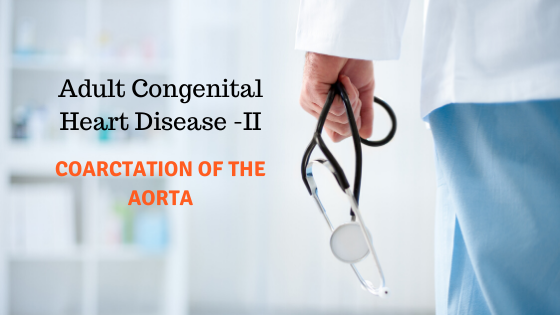COARCTATION OF THE AORTA
This is a timed quiz. You will be given 500 seconds to answer all questions. Are you ready?
Significant aortic coarctation has been defined as mean Doppler systolic gradient greater than –
ANSWER -C
Upper extremity/lower extremity resting peak-to-peak
gradient greater than 20 mm Hg or mean Doppler systolic gradient greater than 20 mm Hg is considered significant Coarctation of Aorta.
Significant aortic coarctation in presence of evidence for collateral flow around the coarctation is defined as -
ANSWER -A
Upper extremity/lower extremity gradient greater than 10 mm Hg or mean Doppler gradient greater than 10 mm Hg when there is evidence for collateral flow around the coarctation is considered significant Coarctation of Aorta.
What % of surgically corrected patients of coarctation of aorta continue to be hypertensive years after surgery –
ANSWER -D
25% of surgically corrected patients continue to be hypertensive years after surgery because of –
Permanent changes in the renin-angiotensin system
Endothelial dysfunction
Aortic stiffness
Altered arch morphology
Which of the following is TRUE for coarctation of aorta?
1. Male-to-female ratio is 2:1
2. Ratio of abdominal-to-thoracic coarctation is approximately 1:1000
3. Abdominal coarctation of the aorta predominantly affects females
ANSWER -D
• Male-to-female ratio is 2:1,
• Abdominal coarctation of the aorta-predominantly affects females.
• The ratio of abdominal-to-thoracic coarctation is approximately 1:1000
Significant aortic coarctation in presence of left ventricular systolic function has been defined as mean Doppler systolic gradient greater than –
ANSWER -A
Upper extremity/lower extremity gradient greater than 10 mm Hg or mean Doppler gradient greater than 10 mm Hg when there is either decreased left ventricular (LV) systolic function or aortic regurgitation (AR) is considered significant Coarctation of Aorta.
Approximately ……………..% of patients with coarctation of the aorta have intracranial aneurysms.
ANSWER -B
Approximately 10% of patients with coarctation of the aorta have intracranial aneurysms
Most common cardiac defect associated with Turner syndrome is –
ANSWER -D
Most common cardiac defect associated with Turner syndrome is Coarctation of aorta.
Coarctation is about twice as common in boys as it is in girls. In Turner syndrome - It is common in girls
“3” sign along the aortic shadow on the PA chest radiograph is seen in –
ANSWER -C
The coarctation region and the poststenotic dilation of the descending aorta may result in a “3” sign along the aortic shadow on the PA chest radiograph (the notch in the “3” representing the area of coarctation).
Which type of coarctation of aorta is seen in Turner syndrome –
ANSWER -A
Preductal coarctation: The narrowing is proximal to the ductus arteriosus
Preductal coarctation - seen in approximately 5% of infants with Turner syndrome
Most commonly associated clinically significant defects associated with coarctation of aorta include all of the following EXCEPT -
ANSWER -A
Most commonly associated clinically significant defects include patent ductus arteriosus, VSD, and aortic stenosis.
Aortic coarctation is extremely rare in patients with severe right ventricular outflow tract obstructions such as tetralogy of Fallot and pulmonary atresia with intact ventricular septum.

